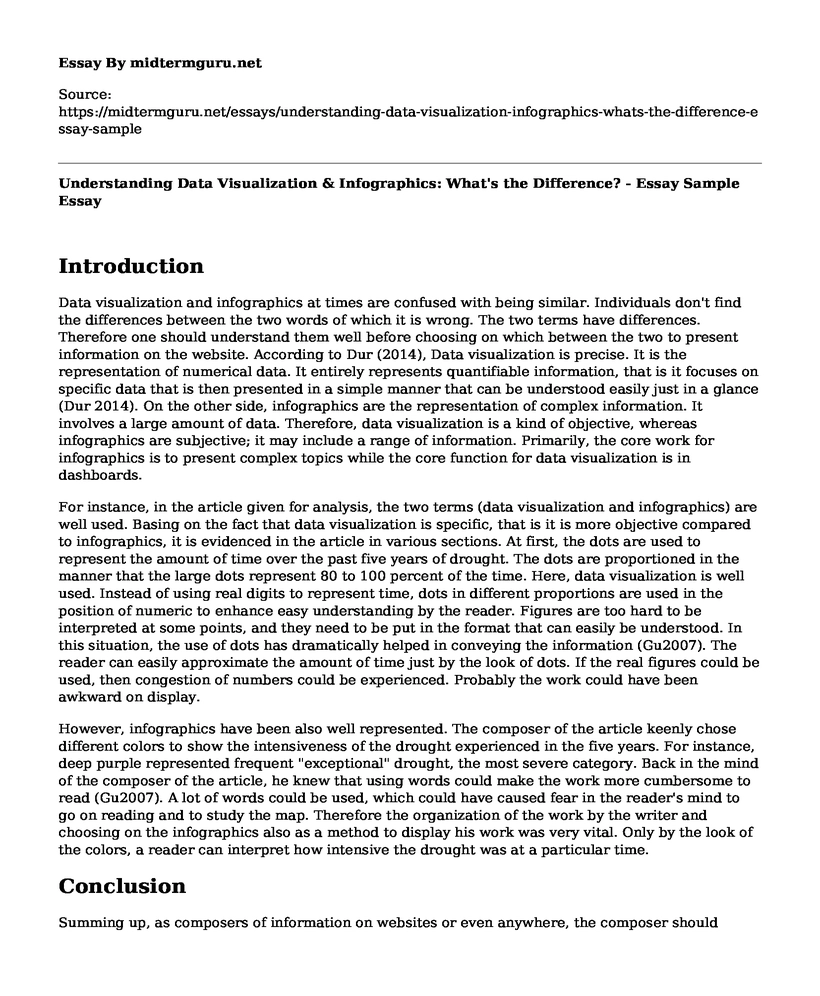Introduction
Data visualization and infographics at times are confused with being similar. Individuals don't find the differences between the two words of which it is wrong. The two terms have differences. Therefore one should understand them well before choosing on which between the two to present information on the website. According to Dur (2014), Data visualization is precise. It is the representation of numerical data. It entirely represents quantifiable information, that is it focuses on specific data that is then presented in a simple manner that can be understood easily just in a glance (Dur 2014). On the other side, infographics are the representation of complex information. It involves a large amount of data. Therefore, data visualization is a kind of objective, whereas infographics are subjective; it may include a range of information. Primarily, the core work for infographics is to present complex topics while the core function for data visualization is in dashboards.
For instance, in the article given for analysis, the two terms (data visualization and infographics) are well used. Basing on the fact that data visualization is specific, that is it is more objective compared to infographics, it is evidenced in the article in various sections. At first, the dots are used to represent the amount of time over the past five years of drought. The dots are proportioned in the manner that the large dots represent 80 to 100 percent of the time. Here, data visualization is well used. Instead of using real digits to represent time, dots in different proportions are used in the position of numeric to enhance easy understanding by the reader. Figures are too hard to be interpreted at some points, and they need to be put in the format that can easily be understood. In this situation, the use of dots has dramatically helped in conveying the information (Gu2007). The reader can easily approximate the amount of time just by the look of dots. If the real figures could be used, then congestion of numbers could be experienced. Probably the work could have been awkward on display.
However, infographics have been also well represented. The composer of the article keenly chose different colors to show the intensiveness of the drought experienced in the five years. For instance, deep purple represented frequent "exceptional" drought, the most severe category. Back in the mind of the composer of the article, he knew that using words could make the work more cumbersome to read (Gu2007). A lot of words could be used, which could have caused fear in the reader's mind to go on reading and to study the map. Therefore the organization of the work by the writer and choosing on the infographics also as a method to display his work was very vital. Only by the look of the colors, a reader can interpret how intensive the drought was at a particular time.
Conclusion
Summing up, as composers of information on websites or even anywhere, the composer should include at least one of the two tactics that are the use of data visualization method or infographics to make his work more fascinating. These methods bring the flavor in the piece of work by making it more understandable. More so, to mitigate the aspect of redundancy in part of work, the two methods can play an essential role if well used.
References
Dur, B.I.U.(2014). Data visualization and infographics in visual communication design education at the age of information. Journal of Arts and Humanities, 3(5), 39-50. Retrieved from http://www.theartsjournal.org/index.php/site/article/view/460
Gu, Y., Brown, J.F., Verdin, J.,& Wardlow, B.(2007). A five-year analysis of MODIS NDVI and NDWI for grassland drought assessment over the central Great Plains of United States. Geophysical Research Letter, 34(6) Retrieved from https://agupubs.onlinelibrary.wiley.com/doi/abs/10.1029/2006GL029127
Cite this page
Understanding Data Visualization & Infographics: What's the Difference? - Essay Sample. (2023, Jan 29). Retrieved from https://midtermguru.com/essays/understanding-data-visualization-infographics-whats-the-difference-essay-sample
If you are the original author of this essay and no longer wish to have it published on the midtermguru.com website, please click below to request its removal:
- Statistical Process Capability - Essay Sample
- Analysis of New Mission of the Thomas Cook Airlines Company - Paper Example
- SWOT Analysis on Connectivity, Culture, and the Future of Work at Uber
- Essay Sample on Summary of the Qualitative Research Applied
- Airport Retail: Design, Passenger Flow & Duty-Free Stores - Essay Sample
- Advantages & Disadvantages of Computers & Internet - Essay Sample
- Understaffing: Is Management Ignorant of the Problem? - Essay Sample







